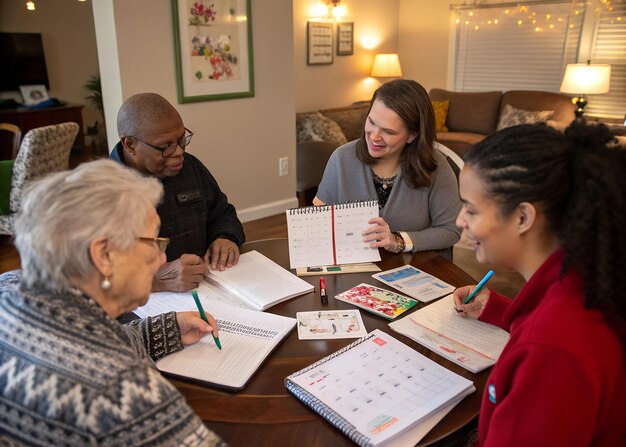Social Security Benefits for Spouses and Dependents: A Comprehensive Guide

Social Security benefits for spouses and dependents provide crucial financial support, ensuring that families of retired, deceased, or disabled workers receive necessary assistance.
Navigating the complexities of Social Security can be daunting, especially when trying to understand the benefits available to spouses and dependents. This guide breaks down the eligibility requirements and application process for Social Security benefits for spouses and dependents, ensuring you have the knowledge to secure the support you deserve.
Understanding Social Security Spousal Benefits
Social Security spousal benefits are designed to provide financial support to the spouses of retired or disabled workers. These benefits acknowledge the contributions of spouses, particularly those who may not have worked or earned enough on their own to qualify for substantial Social Security benefits.
Eligibility Requirements for Spousal Benefits
To be eligible for spousal benefits, several criteria must be met. The applicant must be the spouse of someone entitled to Social Security retirement or disability benefits. Additionally, the spouse must be at least 62 years old or caring for a child under age 16 or a disabled child of the worker. The worker must also be receiving retirement or disability benefits.
How Spousal Benefits are Calculated
The amount of spousal benefits is typically up to 50% of the worker’s primary insurance amount (PIA), calculated at the worker’s full retirement age. However, this amount may be reduced depending on the spouse’s age when they start receiving benefits. If the spouse begins receiving benefits before their full retirement age, the benefit amount will be reduced.

Key factors affecting the calculation include the worker’s PIA, the spouse’s age when claiming benefits, and whether the spouse is also eligible for their own Social Security benefits based on their work history. If the spouse is eligible for their own benefits, they will receive the higher of their own benefit or the spousal benefit.
- Ensure the worker is receiving retirement or disability benefits.
- Check the spouse’s age and whether they are caring for a child.
- Understand how the worker’s PIA affects the spousal benefit amount.
- Determine if the spouse is eligible for their own Social Security benefits.
Understanding these calculations and eligibility requirements is crucial for maximizing the financial support available through Social Security spousal benefits.
Social Security Benefits for Divorced Spouses
Divorced spouses may also be eligible for Social Security benefits based on their former spouse’s earnings. This provision aims to provide financial stability to divorced individuals who may have been financially dependent on their former spouse.
Eligibility for Divorced Spouse Benefits
To qualify for divorced spouse benefits, the marriage must have lasted at least 10 years. The divorced spouse must be unmarried and at least 62 years old. Additionally, the former spouse must be entitled to Social Security retirement or disability benefits. It’s important to note that the amount a divorced spouse receives does not affect the amount the current spouse receives.
How to Apply for Divorced Spouse Benefits
Applying for divorced spouse benefits requires providing documentation such as the divorce decree and proof of the former spouse’s Social Security eligibility. The Social Security Administration (SSA) will review the application and verify the eligibility criteria. It’s advisable to gather all necessary documents before applying to ensure a smooth process.
The application process involves completing the required forms and submitting them to the SSA. Providing accurate and complete information is essential to avoid delays. The SSA may request additional documentation to verify the information provided.
- Ensure the marriage lasted at least 10 years.
- Remain unmarried to maintain eligibility.
- Provide necessary documentation, including the divorce decree.
- Verify the former spouse’s Social Security eligibility.
Navigating the requirements and application process for divorced spouse benefits can provide essential financial support to those who qualify.
Dependent Benefits: Who Qualifies?
Social Security also provides benefits to the dependents of retired, deceased, or disabled workers. These benefits aim to support family members who rely on the worker for financial assistance.
Eligibility Criteria for Dependent Benefits
Eligible dependents typically include children under the age of 18, children of any age who are disabled, and stepchildren, grandchildren, or adopted children under certain circumstances. The worker must be receiving Social Security retirement or disability benefits, or have died after earning enough work credits.
Types of Dependent Benefits Available
Dependent benefits can include monthly payments to eligible children. The amount of the benefit is typically a percentage of the worker’s primary insurance amount (PIA). Each dependent may receive up to 50% of the worker’s PIA, subject to family maximum limits.

Understanding the eligibility criteria and the types of dependent benefits available can help families access the financial support they need. It’s important to gather all necessary documentation and apply promptly to ensure timely receipt of benefits.
The Social Security Administration (SSA) has specific guidelines for determining eligibility and calculating benefit amounts. Consulting with an SSA representative or reviewing the SSA’s publications can provide clarity and guidance.
- Determine if the child is under 18 or disabled.
- Verify the worker’s Social Security status.
- Understand the percentage of the worker’s PIA that dependents may receive.
- Gather necessary documentation for application.
Dependent benefits play a crucial role in supporting families during times of retirement, disability, or loss of a family member.
Applying for Social Security Benefits: A Step-by-Step Guide
The application process for Social Security benefits can be complex, but understanding the steps involved can make the process smoother. Whether you’re applying for spousal, divorced spouse, or dependent benefits, this guide will provide a clear roadmap.
Gathering Required Documents
Before starting the application, gather all necessary documents. This typically includes proof of age (such as a birth certificate), proof of relationship (such as a marriage certificate or divorce decree), and Social Security numbers for all applicants. Additional documents may be required depending on the specific type of benefit.
Completing the Application Forms
The application forms can be completed online through the Social Security Administration’s website or in person at a local Social Security office. Ensure all information is accurate and complete to avoid delays. If applying online, create an account and follow the prompts to complete the application.
For those applying in person, a Social Security representative can assist with completing the forms and answering any questions. It’s advisable to schedule an appointment to ensure dedicated assistance.
- Gather necessary documents, including birth certificates and marriage certificates.
- Complete the application forms online or in person.
- Ensure all information is accurate and complete.
- Seek assistance from a Social Security representative if needed.
Providing accurate information and gathering the required documents are crucial for a successful application.
Factors That Can Affect Your Benefit Amount
Several factors can influence the amount of Social Security benefits you receive. Understanding these factors can help you plan and make informed decisions about when to start receiving benefits.
Impact of Age on Benefit Amount
The age at which you start receiving benefits significantly affects the amount you receive. If you start receiving benefits before your full retirement age, your benefit amount will be reduced. Conversely, if you delay receiving benefits past your full retirement age, your benefit amount will increase.
For spousal benefits, the age at which the spouse starts receiving benefits also affects the benefit amount. Starting benefits before the full retirement age can result in a reduced spousal benefit.
Working While Receiving Benefits
Working while receiving Social Security benefits can also affect your benefit amount, especially if you are under your full retirement age. If your earnings exceed certain limits, the Social Security Administration may reduce your benefits. However, these reductions are not permanent; your benefit will be recalculated at your full retirement age.
The earnings limit varies each year, so it’s important to stay informed about the current limits. Once you reach your full retirement age, your benefits will no longer be reduced, regardless of your earnings.
- Understand how age affects your benefit amount.
- Be aware of the earnings limits if working while receiving benefits.
- Know that benefits may be reduced if starting before full retirement age.
- Stay informed about the current earnings limits and regulations.
Considering these factors can help you make informed decisions about when to start receiving Social Security benefits and how to manage your earnings while receiving benefits.
Common Mistakes to Avoid When Applying
Applying for Social Security benefits can be a complex process, and it’s easy to make mistakes that can delay or reduce your benefits. Being aware of these common mistakes can help you avoid them and ensure a smoother application process.
Inaccurate or Incomplete Information
One of the most common mistakes is providing inaccurate or incomplete information on the application forms. Double-check all information before submitting the application. Ensure that names, dates, and Social Security numbers are correct.
Failing to Provide Required Documents
Another common mistake is failing to provide all required documents. Gather all necessary documents before starting the application process and ensure they are included with your application. Missing documents can delay processing and require additional verification.
Review the checklist of required documents provided by the Social Security Administration and ensure you have everything before submitting your application.
- Double-check all information for accuracy and completeness.
- Gather all required documents before applying.
- Avoid delays by providing complete and accurate information.
- Seek assistance if you are unsure about any part of the application process.
Avoiding these common mistakes can help ensure a smooth and successful application process for Social Security benefits.
| Key Point | Brief Description |
|---|---|
| Eligibility for Spousal Benefits 👵 | Spouse of a beneficiary, 62+ years old, or caring for a child. |
| Divorced Spouse Benefits 💔 | Marriage of 10+ years, divorced and unmarried, 62+ years old. |
| Dependent Benefits 👶 | Children under 18, disabled children, stepchildren, or grandchildren. |
| Factors Affecting Benefit Amount 💰 | Age at claiming, working while receiving benefits. |
FAQ
Yes, a divorced spouse can still receive benefits even if the former spouse remarries. Eligibility is based on the marriage lasting at least 10 years and the divorced spouse remaining unmarried.
If you are under full retirement age, working can reduce your Social Security spousal benefits. Earnings above a certain limit may lead to a temporary reduction in benefits.
You typically need proof of age (birth certificate), proof of marriage (marriage certificate), and Social Security numbers for both you and your spouse when applying for spousal benefits.
Yes, stepchildren are eligible for Social Security dependent benefits under certain conditions. The stepchild must be dependent on the worker at the time of application to qualify.
Yes, you can receive both spousal benefits and benefits based on your own work record. Social Security will pay the higher of the two benefit amounts, but not both in full.
Conclusion
Understanding the eligibility and application process for Social Security benefits for spouses and dependents can significantly impact your financial well-being. By familiarizing yourself with the requirements and avoiding common mistakes, you can navigate the system effectively and secure the benefits you deserve.
